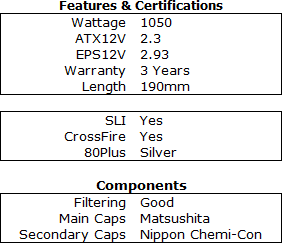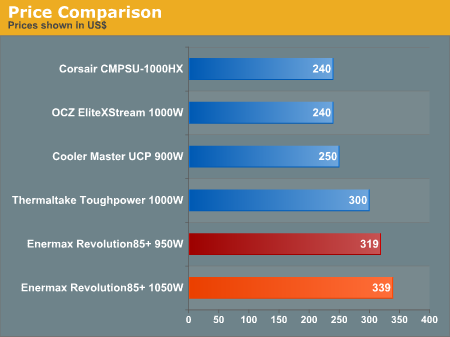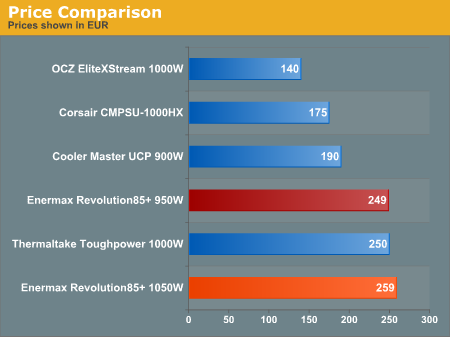Enermax Revolution 85+ High Efficiency PSU
by Christoph Katzer on November 6, 2008 4:15 AM EST- Posted in
- Cases/Cooling/PSUs
Conclusion
Our expectations for this power supply were very high, but we are happy to say that it met its potential in every way. Beauty as always is in the eye of the beholder, but we do like the appearance of the Revolution 85+. The original sample was far more conservative in its design, and when Enermax told us they were revising the look we didn't think it was necessary, since it would probably just increase the price. However, we have to say that the final result does look really cool. The combination of the black textured surface with the red highlights around the fan grille is very attractive in our opinion.
The feature list is similarly impressive, even though most users will not see or recognize some of the innovations. Enermax included a lot of new technologies in this power supply, and the results are very good. It starts with a good topology that lets the two transformers act in synchronization. Another nice feature is the DC-to-DC circuitry that increases efficiency. The not new but still good addition of the 12-pin sockets on the front of the power supply give potential support for future connector developments -- provided of course that the voltage requirements don't change.
The length of the ATX and PEG cables is long enough for most systems. However, if you want to install this power supply in a case where the PSU is in the top rear and the hard drives are in the bottom front, you may have some difficulties getting the cables to reach. Likewise, if the PSU sits in the bottom of your case you might not be able to route all of the cables nicely through the chassis but will have to take a more direct path. The eight 6/8-pin PEG connectors are very nice and make this power supply ready for any GPU configuration all the way up to triple SLI and more. If you're going to use multiple graphics cards, this PSU will likely work best in a bottom-mounted location.
Build quality has never been a concern with Enermax products. About the only problem we've ever encountered were some incompatibilities in the past with a few specific motherboards. Those issues never occurred with higher end PSUs, however, and the Revolution 85+ is clearly the highest of their high-end power supplies. They have included all of the best features from their previous offerings, plus a few new ones for good measure. All of this adds up to the tremendous performance we saw today.
Voltage regulation was good and not even our 10% overload test could cause this unit to sweat. The efficiency is the best we have seen from any previous power supply to date. Enermax states on the package that up to 90% efficiency is possible, and we achieved exactly that with 230VAC. Even with a lower 120VAC input, efficiency still reached an incredible 88%. As mentioned, optimal efficiency generally requires a minimum load of 200W; if you have a system that idles above 200W, you won't need to worry about power supply efficiency for a long time.
Another nice feature is the no load function. As we hinted at earlier, we loaded the power supply using only the 12V rails, keeping the lower voltage 3.3V and 5V rails load-less. We had no trouble at all pulling up to 1000W on the 12V rails without any lower voltage rails, and the PSU still maintained a very nice regulation of just a few millivolts under 12.00V. Of course, with a DC-to-DC circuit the power supply has no total combined power anymore. For reference, when we tried this test on other power supplies, they immediately shut down when either the 3.3V or the 5V rail didn't have any load.
 |
The heatsinks stayed very cool during testing, with temperatures lower than 40°C. Only after running at 110% for a longer period of time did we manage to get heatsink temperatures above 40°C. The fan speed begins increasing with 500W of load and actually lowers temperatures slightly for a while; it's only from 1050W onwards that the heatsink temperatures rise again and the fan can't quite keep up. The drawback is that noise levels are slightly higher than the temperatures warrant; we measured only 29dB(A) under highest load which is still an extraordinary result, but it should have been possible to keep noise levels down even further since the heatsinks aren't that hot at all. Still, it's always better to have a cooler running power supply than to toe the line, which is why Enermax regulates temperatures and fan speeds in this fashion. Keeping the internals at around 40°C at all times is not at all a bad approach, and this should increase the lifespan for this power supply.
Let's compare this unit to other 1000W units and see where it fits. Let's start with the Cooler Master UCP, since there are similarities with the Enermax Revolution 85+. The Revolution 85+ comes with about the same amount of cables and connectors. The PEG connection options are similar but the UCP has them further from the PSU, which is better for users since that provides for better cable routing options. However, Enermax has six 6/8-pin PEG connectors, giving the user greater flexibility. The Corsair HX1000W is also very similar. Compared to units from our 1000W roundup last year, the Enermax Revolution 85+ outperforms all of them. There are more connectors on power supplies now, since manufacturers have discovered that they have plenty of headroom. Power supplies also sport 6/8-pin connectors as well rather than just providing 6-pin PEG, which is a good addition.
In voltage distribution, we don't see really much difference between the Revolution 85+ and many of the competing units tested this year. The Corsair HX1000W has a very good regulation as well, so the Enermax unit has no advantage in this regard. However, when it comes to efficiency there's not much to compare -- after all, we already said the Revolution 85+ is the most efficient power supply we have tested to date. The HX1000W achieves up to 86% and the Cooler Master UCP is close with up to 89% efficiency. This brings Cooler Master back into the game, but if we compare all the additional features (i.e. safety and protection) Enermax leaps ahead again.
The final comparison is pricing. Since each "revolutionary" product that enters the market is usually more expensive than the preceding units, we are not expecting wonders here. We'll let the numbers do the talking:


As expected the MSRP for both units we listed is far above everyone else in the U.S. The Corsair HX1000W is similarly equipped with connectors and offers a wide range of features as well. For a price of around $240 it is a true bargain compared to the others in the list. Still, the Enermax Revolution 85+ offers more and we need to keep in mind that we are using MSRP for now -- street prices will almost certainly be lower. In Europe OCZ sells its EliteXStream for an extremely low price of only 140€, but the others all come close to the Enermax MSRP. Prices should also drop as availability improves, though Enermax will keep it above a certain level as we have seen with the Galaxy series. Enermax knows its advantages over the competition and that will result in prices that should stabilize slightly higher than competing products.
 |
Even though these power supplies are anything but cheap, we are confident in making the statement that the Enermax Revolution 85+ is currently the most advanced consumer power supply available. It offers exceptional efficiency, voltage regulation, temperatures, and has very good build quality. It doesn't necessarily surpass the competition in every area, but it's always at the top of the charts. Ultimately, the innovations, feature set, and performance impress us so much that we are pleased to award the Enermax Revolution 85+ our Gold Editors' Choice Award. It's entirely possible that if you purchase the 1050W model, you could end up running the same PSU for the next couple of presidential elections -- and you can do so knowing your PC will be as green as a hybrid SUV.










49 Comments
View All Comments
xaris106 - Thursday, November 6, 2008 - link
sorry if my english are not good. its not my first language.Aside from that i know what a kilowatt and losses are. I`m not saying they did something wrong. I just wanted some more info on the matter for the pros and cons...
araczynski - Thursday, November 6, 2008 - link
i suppose they're putting all that tech into the very high end market for the same reason as all other techs do; its easy to charge an extra premium (above the normal premium) from those buyers.sooner or later the technology will trickle down into the 'normal' market, where there is more serious volume.
but that's alright, the very high end market just ends up paying our share of the R&D costs that get passed on to them, instead of us.
'bleeding edge' or something they call it? 'bleeding' green :)
JarredWalton - Thursday, November 6, 2008 - link
The real problem is trying to get all of the necessary parts into a "reasonable" PSU, like something in the 600W or lower range for example. I'd guess they probably put around $100-$150 worth of parts and components into this design, making it fit for the high-end but not much else. If you want to sell 500W PSUs, pricing needs to be below $100 for sure to be competitive, and it's just not all that practical to get there with top-end components (IMO).Keep in mind that most people run PSUs at around 50% load if they want peak efficiency, so this PSU is really ideal for anyone running a ~500W system. GTX 280 SLI with an overclocked quad-core would be just about right I think... if you have enough extra HDDs. That it *can* run anything from 200W to 950W with 85% efficiency (and even beyond if you use 230VAC and want to overload the PSU) is extremely impressive.
Phew - Thursday, November 6, 2008 - link
"When I first saw the filtering stage, I asked the representatives at Enermax if CWT is the ODM"I consider myself pretty savvy about computer hardware, and I have two engineering degrees (mechanical), but that sentence was meaningless to me.
If you are going to use multiple obscure acronyms in one sentence, please at least include links to what they stand for and some description. It shouldn't take an electrical engineering degree to understand an article on a 'mainstream' computer hardware website.
yeti514 - Friday, November 7, 2008 - link
I don't know about this PSU, but the PSUs in the link below sure look like some Thermaltake units that were made by CWT to me.http://www.enermaxusa.com/catalog/product_info.php...">http://www.enermaxusa.com/catalog/produ...sCsid=e8...
nevbie - Thursday, November 6, 2008 - link
Channel Well Technologies (company..)Original Design Manufacturer (..which was the manufacturer)
Or along those lines.
Note that this is a mainstream enthusiast computer hardware website. =P
Phew - Thursday, November 6, 2008 - link
When your computer hardware website has a power supply review listed right next to a digital camera review and a Guitar Hero article, that is about as 'mainstream' as it gets.Thanks for the acronym explanation
petersterncan - Thursday, November 6, 2008 - link
I will never buy this line of PSUs unless they came out with a 300-350W model.The systems I build use on-board graphics, on-board audio, one HD, one energy efficient CPU and one optical drive. Fully configured, the systems I build for myself only use around 110 watts. Anything over 350W results in wasted electricity.
Look at the minimum power consumption and efficiency at low power draws! That's the most relevant info for me when selecting a PSU.
Calin - Thursday, November 6, 2008 - link
You can have in USA electrical power on 240V. And the power source will go just as well at 220/230V of Europe as with 240Vstrikeback03 - Thursday, November 6, 2008 - link
Problem would probably be getting the proper cable for the US. Might have to make it yourself.